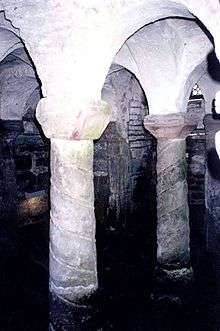Wigstan
| Wigstan (Wystan, Wistan) | |
|---|---|
| Died | 849 |
| Feast | 1 June |
Wigstan (died c.840 AD), also known as Saint Wystan, was the son of Wigmund of Mercia and Ælfflæd, daughter of King Ceolwulf I of Mercia.
History

Like many Mercians of the period very little is known about Wigstan. He was the son of Wigmund and Ælfflæd, both the offspring of Mercian kings, Wiglaf and Ceolwulf I respectively. Wigmund, according to the Croyland Chronicle, died of dysentry before his father King Wiglaf, making Wigstan heir to the kingdom of Mercia. However, when Wiglaf died in 839, he declined the kingship preferring religious life and monastic orders instead. Beorhtwulf, possibly Wigstan's great-uncle, became king instead. William of Malmesbury claims that Beorhtwulf's son, Beorhtric, wished to marry Wigstan's widowed mother, Ælfflæd, but Wigstan forbade the union as they were too closely related. As revenge Beorhtfrith went to visit the young King ostensibly in peace but, when the two greeted each other, he struck Wigstan on the head with the shaft of his dagger and his servant ran him through with his sword.
Beorhtfrith, son of Beorhtwulf, king of Mercia, unjustly put to death his cousin, St Wigstan on the Kalends of June [1st June], being the eve of Pentecost. He was grandson of two of the kings of Mercia; his father, Wigmund, being the son of King Wiglaf, and his mother, Ælfflæd, the daughter of King Ceolwulf. His corpse was carried to a monastery which was famous in that age, called Repton, and buried in the tomb of his grandfather, King Wiglaf. Miracles from heaven were not wanting in testimony of his martyrdom; for a column of light shot up to heaven from the spot where the innocent saint was murdered, and remained visible to the inhabitants of that place for 30 days.
The site of Wigstan's martyrdom has been variously claimed to be Wistanstow (Shropshire), Wistow (Leics) or Wistow (Cambs), which all happen to be derived from his name. Wigstan became a famous saint and Repton became a centre of pilgrimage as a result, which led Cnut the Great to move Wigstan's relics to Evesham, where the Vita Sancti Wistani was written by Dominic of Evesham, a medieval prior there.[1][2]
Hagiography
The saint's relics were relocated to the Abbey at Evesham.[3] His vita (meaning "life", a history recording reputed acts of sanctity) has been attributed to the Benedictine chronicler Dominic of Evesham, an early 12th-century Prior at Evesham. The edifice of the abbey (including the tomb of the four saints and many monastic buildings) were demolished during the Dissolution of the Monasteries, Noted Edwardian artist Margaret E.A. Rope was commissioned for the windows in the parish church in Shropshire dedicated to the miraculous pillar of light leading to discovery of the earthly remains of the slain martyr.
See also
- Anglo-Saxon crypt tomb at Repton, Derbyshire
- British poet W. H. Auden was named in honor of Saint Wystan, video clip of him reading his work, bearing his full name. A familial connection both to Repton school and the church in Shropshire is noted by Auden's biographer Humprey Carpenter.[4]
- Mick Sharp's book The Way and the Light: An Illustrated Guide to the Saints and Holy Places of Britain makes the case for Wistow as the likely location of St Wistan's martyrdom attested to in the legend of the miraculous appearance of human hair on the anniversary of his death, June 1.
Notes
- ↑ "Timeline", Vale of Evesham Historical Society
- ↑ Jennings "Writings" English Historical Review p. 298
- ↑ On St. Wigstan see ‘The Medieval Hagiography of Saint Ecgwine’, p.79 & p.83. This notes that Abbot Ælfweard occupied himself with increasing Evesham’s prestige, and instigated the translation of Saint Wigstan to Evesham, and Evesham Abbey and the Parish Churches: A Guide, p.8. E.J. Rudge, p.13 notes that Ælfweard entreated King Canute to present the abbey church with the relics of Wystan. George May (1834), p.47 refers to St Wulstan. Also see The Victoria History of the County of Worcester, p.387 and ‘The Mitred Abbey of St. Mary, Evesham’, p.12.
- ↑ http://liberalengland.blogspot.com/2007/03/martyrdom-of-st-wystan.html Liberal England blog
Sources
- Jennings, J. C. (April 1962). "The Writings of Prior Dominic of Evesham". The English Historical Review. 77 (303): 298–304. doi:10.1093/ehr/LXXVII.CCCIII.298.
- Walker, Ian, Mercia and the Making of England.
- Yorke, Barbara, Kings and Kingdoms of Early Anglo-Saxon England. London: Seaby, 1990. ISBN 1-85264-027-8
- Zaluckij, Sarah, Mercia: the Anglo-Saxon Kingdom of Central England. Logaston: Logaston Press, 2001. ISBN 1-873827-62-8
